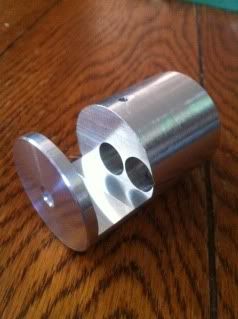ARG
0
- Joined
- Feb 27, 2011
- Messages
- 6,772
- Points
- 113
Hey LPF,
I started this project a quite while ago after admiring Wannaburns 3.5W handheld for so long. Everything is starting to come together and I figured other people would like to see it come together and offer advice.
The original plan was to use two binned M140 diodes with "G" lenses through a PBS cube using a waveplate to maintain the beam orientation then to use prisms for correction. This involved a lot of expensive optics, so a lot of the power would be lost in the beam combining/correction. I also ran into issues when testing the prisms, it was difficult to align it so that the beam came out centered and perpendicular to the host.
Concept:
The plan now is to knife edge the two beams together and use cylindrical optics for the correction. Since I started this the 9mm diodes have also come out, with very good results so I changed the diodes I was going to use to two 9mm diodes. I already have the diodes, and I would test them, but my power supply has been having issues and I don't want to risk killing a 100$ diode.
I estimate that I will get about 2.5W out of each diode running them at ~2A. The losses from the mirrors will be about 5% each and the losses from the cylindrical optics has yet to be tested, I estimate about 15%. This will give me a loss of 25% on one diode, and 15% on the other. This amounts to an estimated 625mW on the lower power diode and a 375mW loss on the higher power diode, totaling 1W loss giving 4W of output. I will test the diodes and position them based on the results such that the one with the lower output will be bounced on the mirrors.
Batteries/Drivers
The power source for this all will be 3x 18650 Panasonic 3100mAh cells in a triple 18650 holder for a total of 12V. The drivers for this all will be two blitz bucks. I was originally going to use a single Flexmod P3 for the interlock and 7 second start up delay features, but it generates unnecessary heat.
Each diode will be driven independently by a blitz buck driver so that I can run them at different currents depending on how efficient each diode is.

A 3D rendering of the heat-sink and optics portion of the host, setscrews holes and threads for a cap to cover up the heatsink/optics not shown.
Edit:

:thanks: for looking.
I started this project a quite while ago after admiring Wannaburns 3.5W handheld for so long. Everything is starting to come together and I figured other people would like to see it come together and offer advice.
The original plan was to use two binned M140 diodes with "G" lenses through a PBS cube using a waveplate to maintain the beam orientation then to use prisms for correction. This involved a lot of expensive optics, so a lot of the power would be lost in the beam combining/correction. I also ran into issues when testing the prisms, it was difficult to align it so that the beam came out centered and perpendicular to the host.
Concept:
The plan now is to knife edge the two beams together and use cylindrical optics for the correction. Since I started this the 9mm diodes have also come out, with very good results so I changed the diodes I was going to use to two 9mm diodes. I already have the diodes, and I would test them, but my power supply has been having issues and I don't want to risk killing a 100$ diode.
I estimate that I will get about 2.5W out of each diode running them at ~2A. The losses from the mirrors will be about 5% each and the losses from the cylindrical optics has yet to be tested, I estimate about 15%. This will give me a loss of 25% on one diode, and 15% on the other. This amounts to an estimated 625mW on the lower power diode and a 375mW loss on the higher power diode, totaling 1W loss giving 4W of output. I will test the diodes and position them based on the results such that the one with the lower output will be bounced on the mirrors.
Batteries/Drivers
The power source for this all will be 3x 18650 Panasonic 3100mAh cells in a triple 18650 holder for a total of 12V. The drivers for this all will be two blitz bucks. I was originally going to use a single Flexmod P3 for the interlock and 7 second start up delay features, but it generates unnecessary heat.
Each diode will be driven independently by a blitz buck driver so that I can run them at different currents depending on how efficient each diode is.

A 3D rendering of the heat-sink and optics portion of the host, setscrews holes and threads for a cap to cover up the heatsink/optics not shown.
Edit:

:thanks: for looking.
Last edited:



